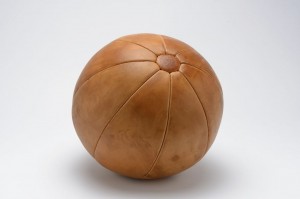 Here is my latest article in Parenting on the Peninsula in the March 2011 edition. I have a monthly column called Coaches Corner.
Here is my latest article in Parenting on the Peninsula in the March 2011 edition. I have a monthly column called Coaches Corner.
Getting Ready for Spring Baseball
By Coach Brien Shamp
I am now in my 10th year as the Baseball Strength & Conditioning Coach at the College of San Mateo. In the college world, baseball is a 9 month process but can be longer if the athlete plays summer baseball. Given the stop & go demands of the game and the tendency to stress the muscles around the elbow & shoulder and the respective joints, it is very important to prepare for the game baseball. The reality is that most likely an injury will prevent the athlete from making it to the next level. What level the athlete makes it to is like Survival of the Fittest. Only the strong survive-whether at the Little League, High School, College or Pro Level.
Common baseball injuries include elbow, shoulder, back, knee, hamstring and ankle injuries. Males tend to have more overuse injuries, sprains & strains due to a lack of flexibility and poor posture. Females tend to encounter more knee and ankle related sprains due to a lack of stability and strength.
At the college level, most athletes are on a year-round training program because college baseball is like a job. The year is typically broken up into Four periods: Off-Season, Fall-Season, Pre-Season and In-Season.
Off-Season is considered a time for recovery, when the athletes are not engaged in baseball related activities. This can be as little as a month or about three months. Their main focus is typically recovering from their past season doing things to stay fit but unrelated to baseball. At the Pro level baseball players are told not to throw a baseball to recover from the daily stress of throwing a baseball.
Fall Season is from September to December and considered a try-out period with some games against each other and against other local teams. The goal is to learn sports specific baseball skills (proper fielding, pitching, running &hitting mechanics), and to get bigger, stronger, faster and more explosive as the Fall-Season progresses.
Pre-Season tends to be very short, generally a month In January. The goal is to get the players back into their training program and build the intensity after the Holidays (a time that seems to create havoc for baseball players and everyone else).
In-Season is February-May. Traditionally during the In-Season, coaches have done more reps at a lighter load or intensity (high volume, low intensity). Given the long season, it is imperative that athletes stay strong, so it is advised to now do less reps and higher loads (low volume, higher intensity). Again, given baseball is related to a high amount of overuse injuries, it is important not to add additional volume in the form of conditioning exercises because this will accelerate the likelihood of injuries. More is not better. Quality of movement should be more important that quantity.
You may think that the above is too advanced for your baseball player in little league, but in today’s world with year round baseball and sports specificity at a young age, there is not much difference between a Little League or Pro Baseball Player. Often times I find that Little League players are even playing more with less rest than Pro Baseball Players. There are new traveling teams being formed often that are keeping kids playing year round. Back in my day we played for only a few months, but now with an interest in college scholarships, millions of dollars in pro contacts and the big business side to traveling teams there is not much of an Off-Season.
Key tips:
Rest and recovery are equally important or more important than work. Kids today are not adapting well to stress-many kids are malnourished, with digestive, immune system and musculo-skeletal weakness’s due to poor environmental conditions, diets & posture, bad sleep habits, overuse of technology & muscles related to one sport.
Posture and flexibility are extremely important to reduce the likelihood of injuries. Daily self massage is highly recommended using foam rollers, Intracell Sticks, and other massage devices to improve joint range of motion and posture. In the ideal world, everyone would have a massage therapist but probably not a realistic likelihood.
At a young age, start your kids in gymnastics, dance or martial arts. These programs tend to be great for improving body awareness, motor skill, posture, self confidence, discipline, flexibility and strength. They also seem to have a greater approval for kids rather than strength training which tends to be boring.
Train like the pros but progress into these activities with time. As I mentioned above, traveling teams are a big business, so is conditioning like the pros. Couple things to think about -does your kid really need to play a sport year round? Do they really need to train like a pro when they do not have the posture, flexibility, stability, strength and other characteristics of Pro Athletes? I often see young athletes holding weights while doing exercises, using parachutes to add resistance when running, using elastic bands to add overload while jumping, etc. Are you kidding me? Most All-American High School Kids at 18 can’t even do exercises with their own body weight well. Start with body weight exercises like squats, lunges, step-ups, push-up holds, assisted pull-ups and core work 2-3 x per week and progress to unstable environments and adding an external loads with time after competency in the movement pattern is achieved.
A thorough dynamic warm-up should be done prior to movement to prepare for sport specific activity. This should include drills that replicate the demands of baseball: arm circles, trunk rotations, lunges, squats, and other rhythmic exercises.
Perform speed, agility and quickness work 2-3 x per week: running mechanics drills, ladders, cones, hurdles, jump ropes, etc.
Aerobic exercise like jogging is of little use for explosive baseball players and can actually increase the likelihood of injury and lead to poor performance. Excessive running mileage leads to overuse injuries which baseball players are already prone to. It has the tendency to create slower, less explosive athletes. Baseball is a game of speed, agility, quickness and power. Those who do not have those characteristics will not do well.
Getting ready for spring baseball is not just about improving on the field performance for your young athlete, but imperative to prepare your athlete for the rigors of the long season and future seasons. Find a Trainer or Conditioning Coach that can help to optimize the conditioning side of the equation. Remember, more is not always better.
I developed a Thrower’s Program for Baseball Players, “The 10 Essential Thrower’s Exercises for Baseball Performance and Injury Reduction.”
You can get this program for FREE at www.BaseballPerformanceEdge.com
If you would like to discuss a Baseball Conditioning Program for your athlete contact me by e-mail or phone.
In Health, Fitness & Vitality,
Brien Shamp BS CSCS CMT CHEK NLC II
Personal Trainer, Nutrition and Lifestyle Coach
www.BrienShamp.com
www.SFBayAreaBootCamp.com
www.MenloFit.com
650-654-4604
Become a Fan of Brien Shamp’s Personal Training, Nutrition & Lifestyle Coaching on Facebook and SF Bay Area Fit Body Boot Camp on Facebook
Please write me a review on YELP for Brien Shamp’s Personal Training, Nutrition & Lifestyle Coaching or SF Bay Area Fit Body Boot Camp
